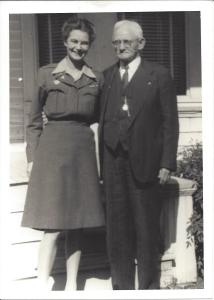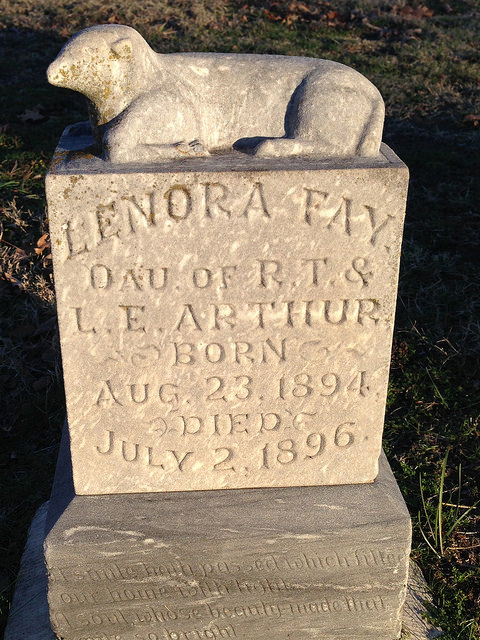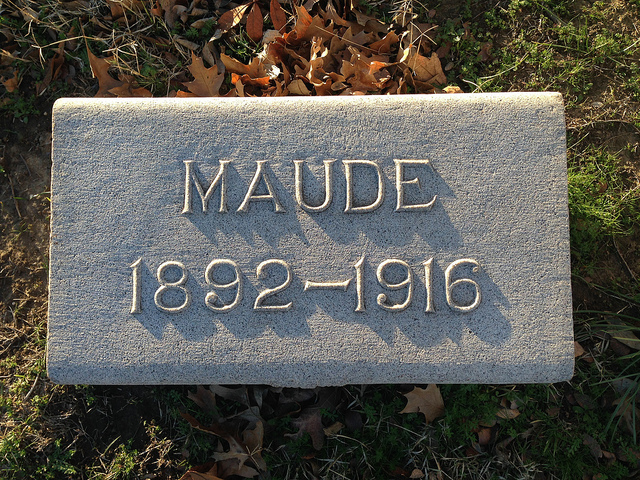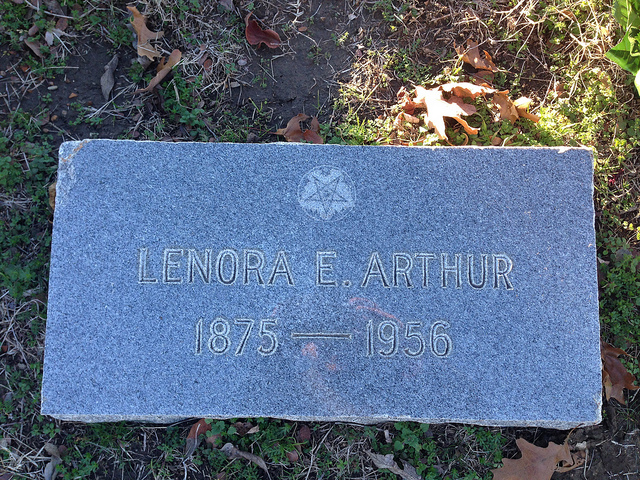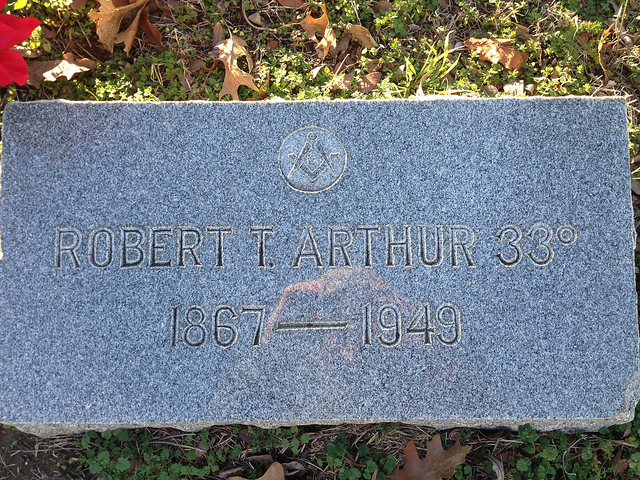Posted: February 11th, 2015 | Author: Matt | Filed under: personal | Tags: Arthur, Denison, DHS, family, Freemasonry, history, MarieArthur, MaudeArthur, MKT, tuberculosis, YellowJacket | 2 Comments »
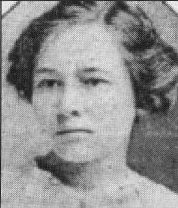
There is a deep human need to be remembered. Most of humanity is forgotten, of course. Many, many people who were successful or beloved or wildly popular are forgotten a generation later. I’ve always been fascinated by books or projects that go back and resurrect a forgotten life and remind us that we have giant gaps in our knowledge of the past. One example is Alain Corbin’s The Life of an Unknown where he picks a name at random from a 19th Century civil registry and researches the history of that particular person as deep and wide as he can. Corbin isn’t writing an academic microhistory there, but actually trying to repair holes in our collective memory.
In previous posts on Robert T. Arthur, I was curious about how his daughter, Maude (above), died so young. She was only 23 when she died in 1916. After reading more about her life, I feel like I have discovered a remarkable person.
By all accounts, Maude had the trademark personality of a first born child: a leader, smart, willing to please. But tragedy struck her young family when she was 4 years old. Her baby sister, Lenora Fay, only 22 months old, died while the family was in Fort Scott, Kansas. (I’m not sure if Maude was also born in Fort Scott or if this was just a brief stay in Kansas. Like Denison, Fort Scott was a Katy Railroad stop and it’s likely he was on assignment there.) No doubt Maude carried some of her parents’ burden over that unforgettable tragedy throughout her life. Her parents did have another child, another girl, Marie, in 1902 when Maude was already 10. The difference in ages meant they were not likely as close as they would have liked to be. When Marie was ten years old, Maude had already graduated high school.
In high school, Maude was at the center of the social world. The Denison High School class of 1911 was small, but Maude stood out. In her junior year she was the Society Editor of the Denison High School Yellow Jacket (the yearbook which also published newsletters at the time). She was also an aspiring writer. Here is a story she contributed to the Christmas 1910 Yellow Jacket. (I transcribed it below.) I think the story displays incredible maturity for an 18 year-old girl and a real ability at crafting stories.
The Bernhardts Christmas Gift
By Maude Arthur
The cottage homes of the Bernhardts stood side by side in exact duplicate with the hanging baskets on the porch and the well laid off vegetable garden in the rear. So was the relation of the families. But of late the Mesdames Bernhardts, who had always begun and ended their house-cleaning seasons on the same day, whose preserves and jellies tallied to a jar and who made their patchwork quilts from the same pattern, had gotten in the habit of shaking their heads and lamenting that Herman and August were not happy any more spending their days in making their compounds or sitting on the green bench in the evenings smoking their long-stemmed pipes. Nowadays the men spent all their time in their laboratory, which stretched along the end of the two yards, and worked in bad smelling messes and evil looking mixtures. “And no good would come of this,” said Mena to Lena.
When the cousins took in a partner, a shock-headed young man with a queer uncatchable eye that never looked straight at anyone, Mena said it was nothing than the doings of the unsound minds of the cousins; for outside of this, August, her husband, had talked recently in his sleep about a “solution” that would bring him wealth beyond measure. When questioned about it, he became angry, but finally told her that he had come upon a combination of certain liquids that lacked but one ingredient to make a substance from which the most beautiful jewels could be made. This one ingredient he would find then hey for fame. He said that Herman had helped a little, but only a very little, the idea was his, August’s and the fame would be given him when the time came.
Lena also questioned her husband about the wonderful discovery, Herman seemingly informed her that the fame belonged to him and that August was only helping him. However, she would see when the missing link was found who would get the glory. The new partner who was experienced in chemical matters had been taken on to assist in the detail work and to help along the research for the last ingredient.
Then the lives of the two fraus became miserable, for they loved their husbands dearly and they loved each other dearly. They now foresaw the troublesome times ahead. The breach between the two families soon widened; both Herman and August became cross and sullen toward each other and each bade his wife not to visit or have anything to say to the wife of the other. Sorrow and dismay descended on the good wives, whose stolen interviews could not bring much comfort since Herman and August were at the point of blows.
One morning a fearful shock came to August and Mena; during the night Herman had stolen away taking with him his wife, the rascally new partner, and all of the precious discovery.
Up and down the white-colored kitchen raged the cheated cousin, wrenching his gray hair into wild disorder and bidding Mena hold her tongue when she tried to comfort him. Then his mood changed and he vowed to find his tricky kinsman, though it cost him years of life and hundreds of dollars, and wrest from him the magic compound which he had stolen. This was a vast undertaking. Herman’s house had been shut up, and no one could be found who was able to throw any light on the subject.
Soon August prepared to leave on his strange quest. The cottage was locked up, the cat given to a neighbor, and Mena beheld but a quivering mist as, with tear-blurred eyes, she bade farewell to her beloved cabbage garden.
Then followed the long, dreary pilgrimage of the aged couple. Now and then vague tidings of Herman’s movements came to them, but finally giving up all hope of finding his cousin, he settled in a little cottage far distant from his old home and fitted up a miniature laboratory where he worked day and night to duplicate the priceless mixture which had been stolen from him. But it was useless as he’d forgotten the very ingredients as well as the details of the process.
Mena, worn out with the long and fruitless search, was glad to have some scrubbing, washing, and something to do. August, who was so low in spring, would help her in nothing, so the poor soul was obliged to potter around with her pantry-shelves, her newly sorted window plants and such balm-giving occupations. It was a good day for her when she discovered a curious closet under the stair with a ….. like this paneling that therefore she had overlooked it. Then she bought her…. (If you’d like to read the rest of the story, please click here: http://www.rootsweb.ancestry.com/~txgrayso/GatheredTogether/SCHOOL/SCHOOLS/DenisonHighSchool/DHSHistory/1910YJ_Xmas/1910Xmas_4.html
—-
Some context about this story: Denison High School had recently built a chemistry lab on campus. It was considered the height of sophistication and scientific advancement. Marie Curie was all over the newspapers then, having won the 1903 Nobel Prize in physics (she would also win the 1911 Nobel Prize in chemistry). The women’s suffrage movement was acquiring an air of inevitability and progressive young women, like Maude, were looking to do more than study home economics.
During Maude’s high school years, the Arthur family lived at 1030 W. Sears St. in Denison (they had moved from 700 W. Owings St., and in later years the Arthur family lived at 1023 W. Morton).

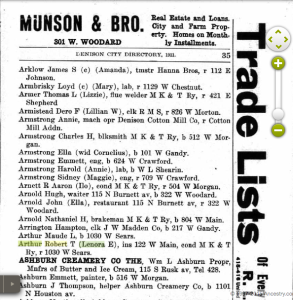
It was at this house where Maude hosted the high school class for a Halloween party, which she described in her society column in the 1910 Yellow Jacket.
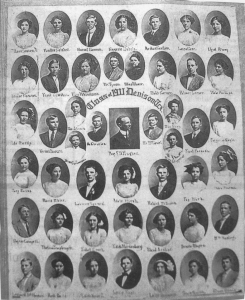
[Maude’s boyfriend was Leslie Cash, on the bottom row here, in the center, with the dark suit. He’s also the “One Who Loved Her” who wrote the tribute to her, below.]
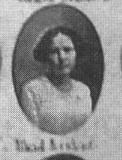
Maude
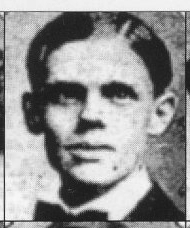
Leslie Cash
(These photos are terrible quality-wise but they are all I have found so far.)
Leslie Cash later moved to Oklahoma and married a woman named Glennis. Their son, Robert, was born in 1924 and served in World War II. He passed away in 2013, but his experience as a prisoner of war in Europe is quite incredible:
He trained as a radio operator and top turret gunner on the B-24 Liberator. He was with the 8th Air Force, 492nd Bomb Group, based in Norwich, England. He was privileged to fly on D-Day, June 6, 1944. Two weeks later, on his 13th mission, his aircraft was shot down over the Baltic Sea. Bob was badly burned and wounded. He bailed from the burning plane, was rescued by German Marines and classified as a POW. At the time, he didn’t know it, but Bob was the sole survivor of a crew of 10 men. Not a day in his life went by without remembrance of those crewmen. He spent more than 10 months as a POW, living on quarter rations. On Feb. 6, 1945, they struck out in the snow for what they were told was a 16-day march that ended 90 days and 800 miles later from the starting point. It was aptly named “The German Death March,” as some 2,500 POWs perished on that march. The British 11th Armored Division, one week before peace was declared in Europe, mercifully liberated them.
Â
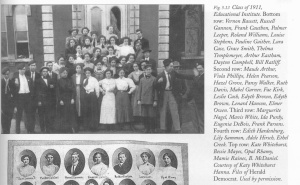
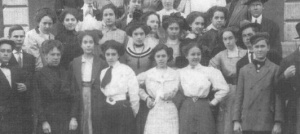
Shortly after these school photos were taken, for her senior year, Maude got sick. She was diagnosed with tuberculosis shortly after she graduated high school and her condition worsened. In the first decade of the twentieth century, tuberculosis was
so common that many families had a consumptive member. The disease was little understood and prevention included
anti-spitting campaigns, an increase in hygiene, and various types of supplemental air.
(A typical sanatorium for tuberculosis patients in Texas.)
In early 1914, the Arthur family decided to move to a dryer, desert climate in west Texas. Robert T. Arthur kept an apartment at a rooming house at 214 N. Mirick Ave. It was thought that dry, desert air could help cure tuberculosis. There were
two smaller sanatoriums in San Angelo and a larger colony just outside San Angelo, founded in 1909 (sometimes called “
Sanatorium, Texas“.) It’s not clear to me yet which of these housed Maude. Her sister Marie stayed behind in Denison to attend school. The 1915 city directory lists only Robert T. as a resident of Denison.
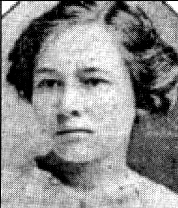
Alas, she didn’t survive. Maude L. Arthur died in San Angelo, Texas, at the age of 23.
(As before, I am transcribing these newspaper articles so that the text may be searchable.)
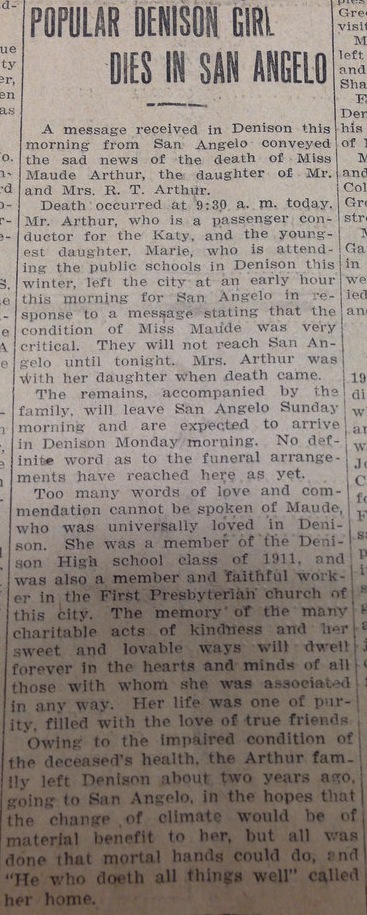
Denison Daily Herald, January 8, 1916
Popular Denison Girl Dies in San Angelo
A message received in Denison this morning from San Angelo conveyed the sad news of the death of Miss Maude Arthur, the daughter of Mr. and Mrs. R. T. Arthur.
Death occurred at 9:30 a.m. today. Mr. Arthur, who is a passenger conductor for the Katy, and the youngest daughter, Marie, who is attending the public schools in Denison this winter, left the city at an early hour this morning for San Angelo in response to a message stating that the condition of Miss Maude was very critical. They will not reach San Angelo until tonight. Mrs. Arthur was with her daughter when death came.
The remains, accompanied by the family, will leave San Angelo Sunday morning and are expected to arrive in Denison Monday morning. No definite word as to the funeral arrangements have reached here as yet.
Too many words of love and commendation cannot be spoken of Maude, who was universally loved in Denison. She was a member of the Denison High school class of 1911, and was a member and faithful worker in the First Presbyterian church of this city. The memory of the many charitable acts of kindness and her sweet and lovable ways will dwell forever in the hearts and minds of all those with whom she was associated in any way. Her life was one of purity, filled with the love of true friends.
Owing to the impaired condition of the deceased’s health, the Arthur family left Denison about two years ago, going to San Angelo, in the hopes that the change of climate would be of material benefit to her, but all was done that the mortal hands could do, and “He who doeth all things well” called her home.]
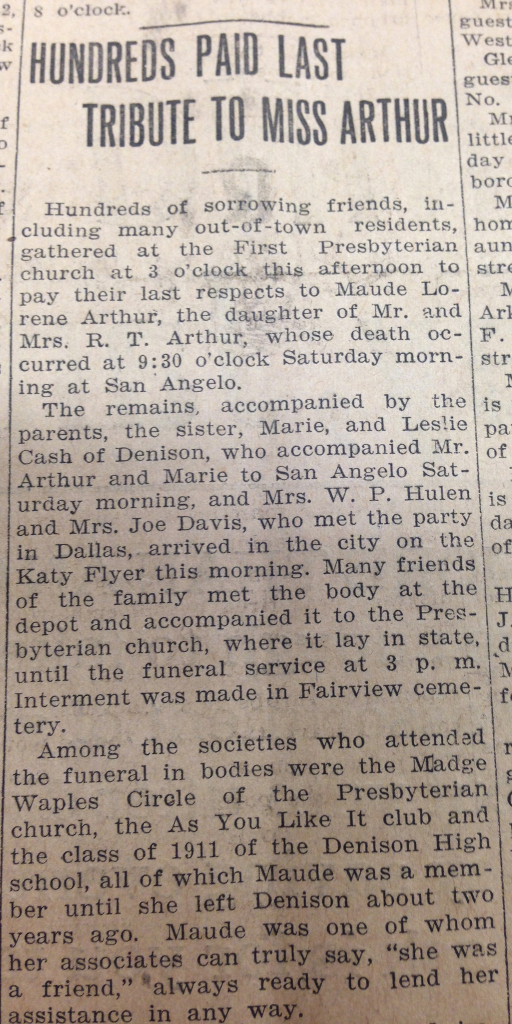
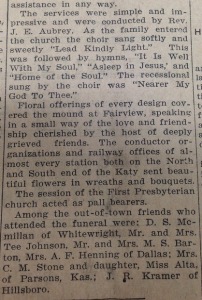
[Denison Daily Herald, January 10, 1916
Hundreds Paid Last Tribute to Miss Arthur
Hundreds of sorrowing friends, including many out-of-town residents, gathered at the First Presbyterian church at 3 o’clock this afternoon to pay their last respects to Maude Lorene Arthur, the daughter of Mr. and Mrs. R. T. Arthur, whose death occurred at 9:30 o’clock Saturday morning at San Angelo.
The remains, accompanied by the parents, the sister, Marie, and Leslie Cash of Denison, who accompanied Mr. Arthur and Marie to San Angelo Saturday morning and Mrs. W. P. Hulen and Mrs. Joe Davis, who met the party in Dallas, arrived in the city on the Katy Flyer this morning. Many friends of the family met the body at the depot and accompanied it to the Presbyterian church, where it lay in state, until the funeral service at 3 p.m. Interment was made in Fairview cemetery.
Among the societies who attended the funeral in bodies were the Madge Waples Circle of the Presbyterian church, the As You Like It club and the class of 1911 of the Denison High school, all of which Maude was a member until she let Denison about two years ago. Maude was one of whom her associates can truly say “she was a friend,” always ready to lend her assistance in any way.
The services were simple and impressive and were conducted by Rev. J.E. Aubrey. As the family entered the church the choir sang softly and sweetly “Lead Kindly Light.” This was followed by hymns, “It Is Well With My Soul,” “Asleep in Jesus,” and “Home of the Soul.” The recessional sung by the choir was “Nearer My God To Thee.”
Floral offerings of every design covered the mound at Fairview, speaking in a small way of the love and friendship cherished by the host of deeply grieved friends. The conductor organizations and railway offices of almost every station both on the North and South end of the Katy sent beautiful flowers in wreaths and bouquets.
The session of the First Presbyterian church acted as pall bearers.
Among the out-of-town friends who attended the funeral were: D.S. Mcmillan of Whitewright, Mr. and Mrs. Tee Johnson, Mr. and Mrs. M.S. Barton, Mrs. A.F. Henning of Dallas; Mrs. C.M. Stone and daughter, Miss Alta, of Parsons, Kas.; J.R. Kramer of Hillsboro.]
Researching all of this about Maude has deeply affected me. I have given great consideration to the fact that Maude Arthur has not walked this earth in almost 100 years but her headstone remains in near-perfect condition. I have considered how advances in medicine and transportation have changed our ability to prolong life over the course of a century. I have pondered the nature of success and accomplishment and how little of it truly endures, mostly due to the whims of an uncontrollable fate.
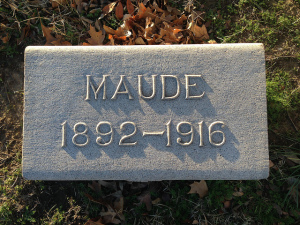
Rest in peace, Maude.
Posted: September 24th, 2014 | Author: Matt | Filed under: personal | Tags: DeMolay, Denison, FoundersCross, FrankSLand, Masons, MKT, Railroad, RobertArthur, Texas | 4 Comments »
As a Senior DeMolay, I was intrigued by Seth Anthony’s quest to track down all 137 recipients of the DeMolay Founder’s Cross. The Founder’s Cross was presented by Dad Frank S. Land, founder of the Order of DeMolay, to individuals personally loyal to him. After Dad Land’s death in 1959, no further Founder’s Crosses were awarded. The first Founder’s Crosses were awarded in 1937. Its relative scarcity, and the high profile of many recipients, makes it perhaps the most prestigious award in the history DeMolay.
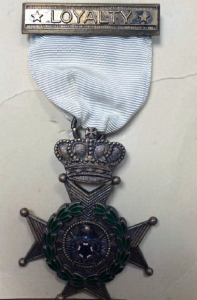
In Seth Anthony’s spreadsheet of recipients, one name stood out to me: Robert T. Arthur. It was notable not because I knew Dad Arthur—he died in 1949—but because he was a resident of Denison, Texas.
My family is from Denison. I went to Kindergarten and first grade there, my brother was born there, my mom, both my grandmothers, and many aunts and uncles still live there. It is as much of a homeland as I’ve ever had. But I know they have not had a DeMolay chapter there in a very long time. I joined the Order of DeMolay in Texas (Tyler) in 1992, and the chapter in Denison was a distant memory even then.
I considered myself familiar with the history of Texas DeMolay, but I had never heard of Dad Arthur. So I enlisted the help of everyone I could find to help track down some vital details about Robert T. Arthur on the distant hope that he might have some surviving relatives who could tell us more about him or what happened to his Founder’s Cross.
One individual, in particular, stepped forward to assist me in this search: Jim Sears. To him, I owe many thanks for tracking down these newspaper articles. His research skills are second-to-none. All of the photos below are a product of his research. Thank you, Jim.
The Railroad Man
Robert T. Arthur was born in Missouri in 1867. His family moved to Pilot Point, in Denton County, Texas, when he was young. Pilot Point is the oldest settlement in Denton County. It is still an operating city (unlike nearby Pilot Grove, birthplace of Benny Binion), and is still associated with horse breeding. Arthur graduated from Denton Normal school (now called the University of North Texas). He then worked in Denton as a school teacher before moving to Denison to take a job with the Katy Railroad in 1889. He worked as a conductor on passenger rail lines for over 50 years. In 1893, at the age of 26, he was elected an officer (Senior Conductor) in the Denison Division of the Order of Railway Conductors (the union representing passenger rail workers).
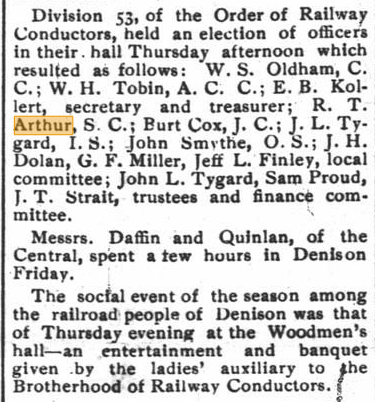
These newspaper articles are sometimes hard to read (and the text should be indexed by search engines) so I will transcribe them throughout.
[Sunday Gazetteer, Denison Texas, December 31, 1893
Division 53, of the Order of Railway Conductors, held an election of officers in their hall Thursday afternoon which resulted as follows: W.S. Oldham, C.C.; W.H. Tobin, A.C.C.; E.B. Kollert, secretary and treasurer; R.T. Arthur, S. C., Burt Cox, J.C.; J.L. Tygard, I.S.; John Smythe, O.S.; J.H. Dolan, G.F. Miller, Jeff L. Finley, local committee, John L. Tygard, Sam Proud, J.T. Strait, trustees and finance committee.
Messrs. Daffin and Quinlan, of the Central, spent a few hours in Denison Friday.
The social event of the season among the railroad people of Denison was that of Thursday evening at the Woodmen’s hall, an entertainment and banquet given by the ladies’ auxiliary to the Brotherhood of Railway Conductors.]
The ritual for the ORC was very similar to a Masonic ceremony, so it’s not surprising that these men were members of several other fraternal organizations. Here is an example of an ORC membership card around the time Arthur joined the Brotherhood:

[image via https://www.flickr.com/photos/aemays/5618961385/]
R.T. Arthur married Ms. Lenora Tipton in Denison on July 22, 1891. The couple had three daughters: Faye, who died in infancy; Maude, who died in 1916 at age 24, and Marie, who later married Roy Miller. Robert and Lenora celebrated 50 years of marriage in Denison in 1941. He was the organizer and first advisor to the Denison Chapter of DeMolay, founded in 1921. Much of this information is gleaned from the 1941 newspaper article below.
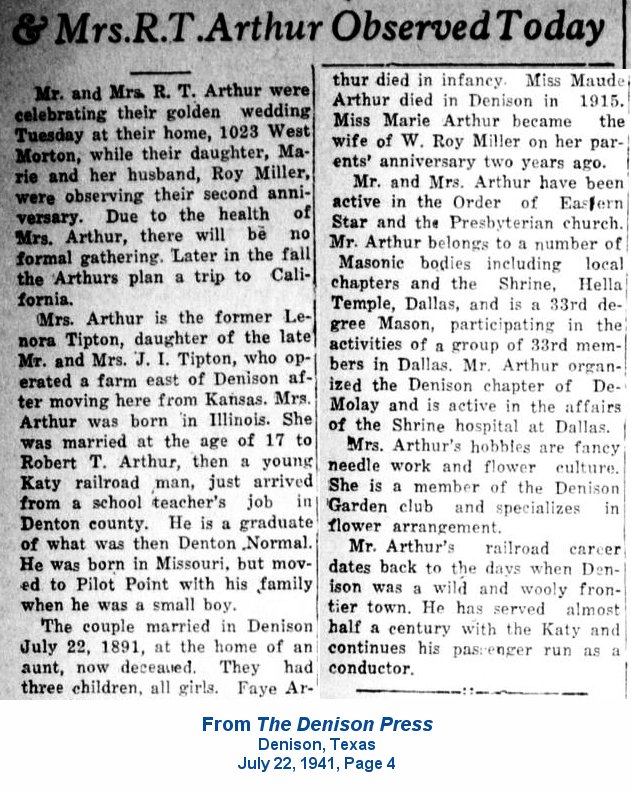
[From The Denison Press, July 22, 1941
Mr. and Mrs. R.T. Arthur were celebrating their golden wedding Tuesday at their home, 1023 West Morton, while their daughter, Marie and her husband, Roy Miller, were observing their second anniversary. Due to the health of Mrs. Arthur, there will be no formal gathering. Later in the fall the Arthurs plan a trip to California.
Mrs. Arthur is the former Lenora Tipton, daughter of the late Mr. and Mrs. J.I. Tipton, who operated a farm east of Denison after moving here from Kansas. Mrs. Arthur was born in Illinois. She was married at the age of 17 to Robert T. Arthur, then a young Katy railroad man, just arrived from a school teacher’s job in Denton county. He is a graduate of what was then Denton Normal. He was born in Missouri, but moved to Pilot Point with his family when he was a small boy.
The couple married in Denison July 22, 1891, at the home of an aunt, now deceased. They had three children, all girls. Faye Arthur died in infancy. Miss Maude Arthur died in Denison in 1915. Miss Marie Arthur became the wife of W. Roy Miller on her parents’ anniversary two years ago.
Mr. and Mrs. Arthur have been active in the Order of Eastern Star and the Presbyterian Church. Mr. Arthur belongs to a number of Masonic bodies including local chapters and the Shrine, Hella Temple, Dallas, and is a 33rd degree Mason, participating in the activities of a group of 33rd members in Dallas. Mr. Arthur organized the Denison chapter of DeMolay and is active in the affairs of the Shrine hospital at Dallas.
Mrs. Arthur’s hobbies are fancy needle work and flower culture. She is a member of the Denison Garden club and specializes in flower arrangement.
Mr. Arthur’s railroad career dates back to the days when Denison was a wild and wooly frontier town. He has served almost half a century with the Katy and continues his passenger run as a conductor.]
Through his travels as a railroad conductor, R.T. Arthur was able to travel across Texas at free or reduced rates, easily attending Scottish Rite, Shrine, and DeMolay meetings in Dallas and beyond.
It’s telling that a man, like Frank S. Land himself, who had no sons of his own, organized a group of young men into a fraternal organization that was a model for others. What tragedy to bury two daughters.
His surviving daughter, Marie, married Roy Miller and taught at Denison High School for many years.
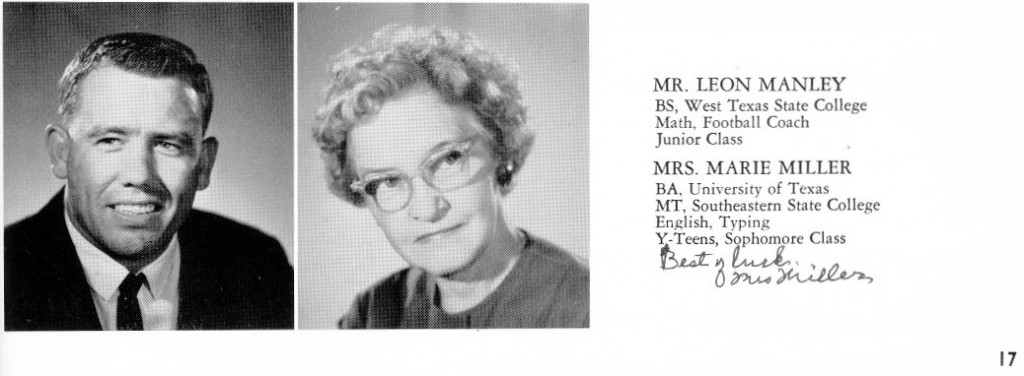
She passed away in 1991, leaving Robert T. Arthur with no living descendants.
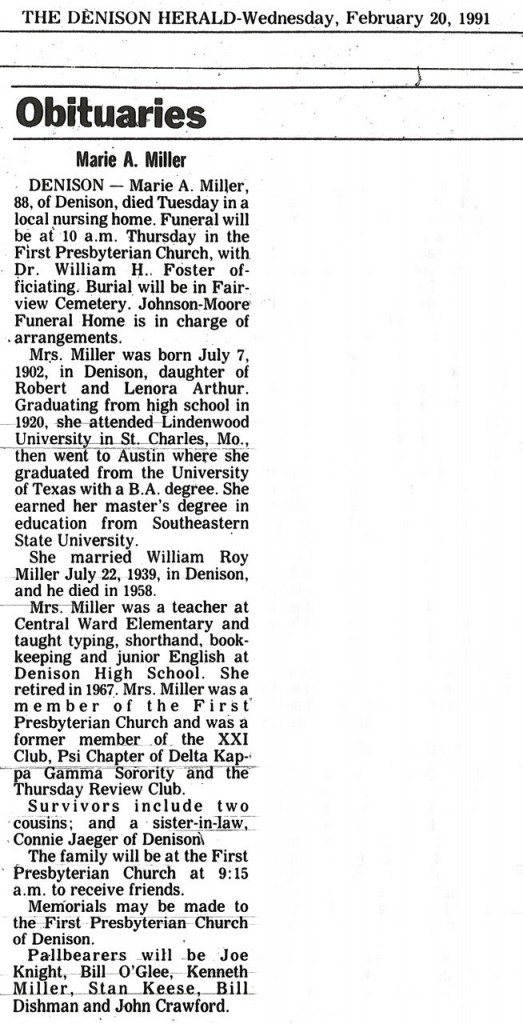
Denison DeMolay
The Order of DeMolay for boys was organized Frank S. Land in Kansas City, Missouri. The first meeting was held March 24, 1919. More chapters were quickly founded across the country.
The chapter in Denison, Texas, was organized in January 1921. It was the 200th chapter founded, with Letters Temporary granted on January 28, 1921. Denison was one of the first chapters of DeMolay in Texas. Ameth Chapter, in El Paso, was the first: it was founded in 1920.
The Denison High School Yearbook from 1937 includes this page of the members and a brief history of the chapter.
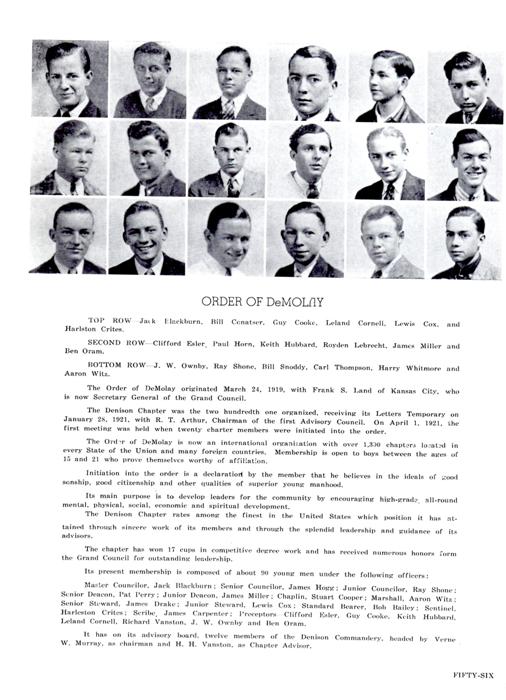
[Denison, Texas, High School Yearbook, 1937
ORDER OF DeMOLAY
TOP ROW: Jack Blackburn, Bill Conatser, Guy Cooke, Leland Cornell, Lewis Cox, and Harlston Crites
SECOND ROW: Clifford Ealer, Paul Horn, Keith Hubbard, Royden Lebrecht, James Miller, and Ben Oram
BOTTOM ROW: J.W. Ownby, Ray Shone, Bill Snoddy, Carl Thompson, Harry Whitmore, and Aaron Witz
The Order of DeMolay originated March 24, 1919, with Frank S. Land of Kansas City, who is now Secretary General of the Grand Council.
The Denison Chapter was the two hundredth one organized, receiving its Letters Temporary on January 28, 1921, with R.T. Arthur, Chairman of the first Advisory Council. On April 1, 1921, the first meeting was held when twenty charter members were initiated into the order.
The Order of DeMolay is now an international organization with over 1330 chapters located in every State of the Union and many foreign countries. Membership is open to boys between the ages of 15 and 21 who prove themselves to be worthy of affiliation.
Initiation into the order is a declaration by the member that he believes in the ideals of good sonship, good citizenship and other qualities of superior young manhood.
Its main purpose is to develop leaders for the community by encouraging high-grade, all around mental, physical, social, economic and spiritual development.
The Denison Chapter rates among the finest in the United States which position it has sustained through sincere work of its members and through the splendid leadership and guidance of its advisors.
The chapter has won 17 cups in competitive degree work and has received numerous honors from the Grand Council for outstanding leadership.
Its present membership is composed of about 50 young men under the following officers:
Master Councilor, Jack Blackburn; Senior Councilor, James Hogg; Junior Councilor, Ray Shone; Senior Deacon, Pat Perry; Junior Deacon, James Miller; Stuart Cooper, Chaplain; Aaron Witz, Marshal; James Drake, Senior Steward; Lewis Cox, Junior Steward; Bob Bailey, Standard Bearer; Harleston Crites, Sentinel; James Carpenter, Scribe; Preceptors: Clifford Ealer, Guy Cooke, Keith Hubbard, Leland Cornell, Richard Vanston, J.W. Ownby, and Ben Oram.
It has on its advisory board twelve members of the Denison Commandery, headed by Verne W. Murray, as chairman and H.H. Vanston as Chapter Advisor.]
Here are some of the Denison High School year book (The Yellowjacket) pages for the DeMolay club in the 1920s. Here is 1924:
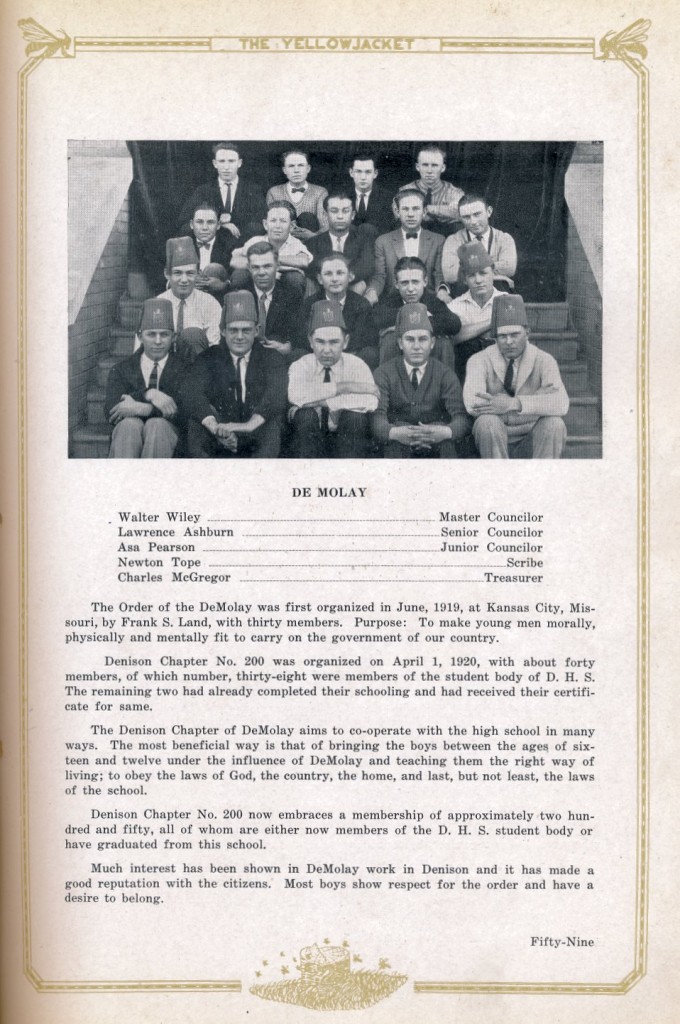
And here is 1925: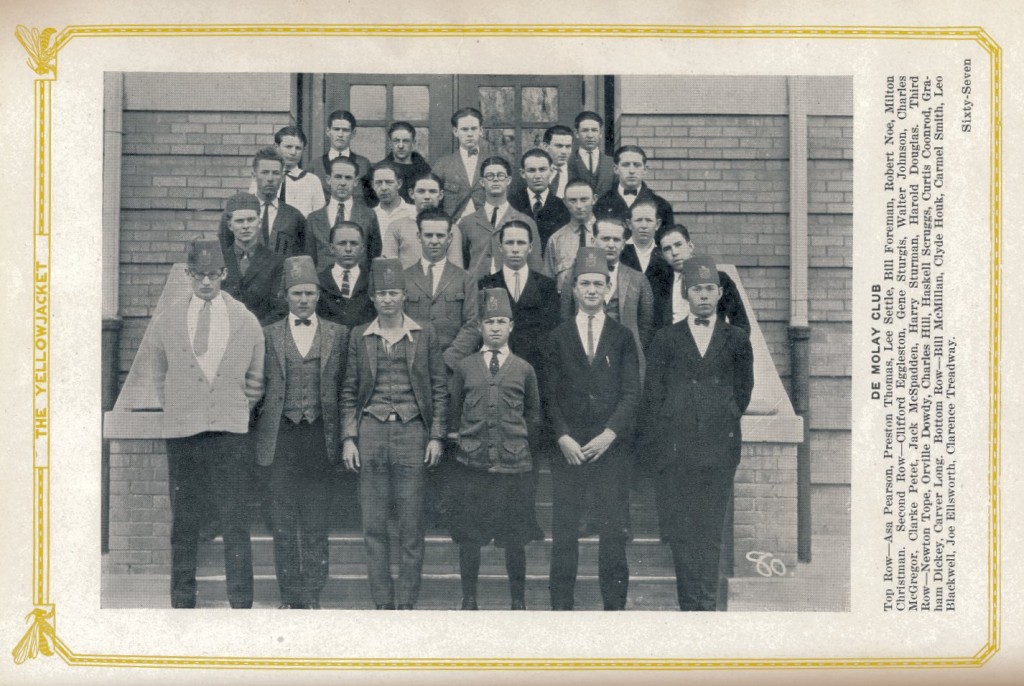
As far as I can tell, the chapter was active and productive from 1921 until the 1960s. One of the high points in the life of the chapter came in 1937 when Dad Arthur was awarded the Founder’s Cross by Frank S. Land at the Conclave in Waco.

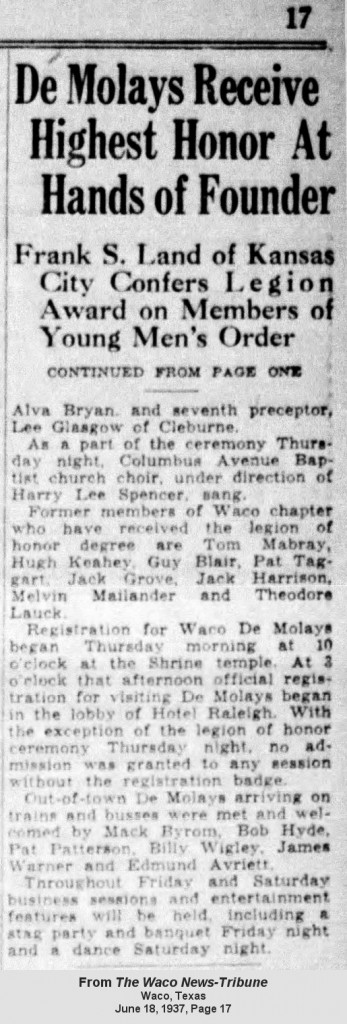
[Waco News-Tribune, June 18, 1937
DeMolays Receive Highest Honor at Hands of Founder
Frank S. Land of Kansas City Confers Legion Award on Members of Young Men’s Order
3 Wacoans given Special Awards
Alva Bryan, Robert Arthur and Lee Dewey Are Handed Crosses in Recognition of Work
The legion of honor, the highest distinction which a DeMolay can receive, was conferred on five young men of Texas last night by Frank S. Land of Kansas City, founder of the Order of DeMolay. Mr. Land also presented for the first time in the history of the order, his personal founders cross to three men, Alva Bryan, Robert Arthur, and Lee Dewey in recognition of their faithful work with DeMolay in Texas.
Those who received the legion of honor for outstanding leadership in some worthwhile endeavor are as follows: Mandell H. Cline, Mexia; Elwood Henry Brown, Houston; Maxwell Goodman, Fort Worth; Randolph Jackson, Hillsboro, and Robert Lewis, Hillsboro.
Altar is in White
At an altar of white, surrounded by white candles, the five candidates for the degree knelt and took their vows from Mr. Land. Each preceptor placed a bouquet on the altar. A choir furnished the music. This degree was the first event of a three-day session of the state DeMolay conclave, which continues through Saturday. Today there will be the business sessions until 5:30 p.m. at which time there will be a downtown parade featuring stunts, and each chapter in Texas will be represented. A banquet and three-hour floor show will be presented tonight starting at 7:30 o’clock for all registered DeMolays.
Officers in Ceremony
Officers who conducted the ceremony were as follows: Commander in the east, Frank S. Land; Commander in the west, James Blundell; commander in the south, Pat Taggart; herald, Sidney Dobbins; grand marshal, J. Floyd Smith; grand chaplain, Jack H. Harrison; first preceptor, R.L. Othling; second preceptor, Hugh Keahey; third preceptor, George Denton; fourth preceptor, Billy Smith; fifth preceptor, George Lovell; sixth preceptor, Alva Bryan; and seventh preceptor, Lee Glasgow of Cleburne.
As apart of the ceremony Thursday night, Columbus Avenue Baptist church choir, under direction of Harry Lee Spencer, sang.
Former members of Waco chapter who have received the Legion of Honor degree are Tom Mabray, Hugh Keahey, Guy Blair, Pat Taggart, Jack Grove, Jack Harrison, Melvin Mailander and Theodore Lauck. Registration for Waco DeMolays began Thursday morning at 10 o’clock at the Shrine temple. At 3 o’clock that afternoon official registration for visiting DeMolays began in the lobby of Hotel Raleigh. With the exception of the legion of honor ceremony Thursday night, no admission was granted to any session without the registration badge.
Out-of-town DeMolays arriving on trains and busses were met and welcomed by Mack Byrom, Bob Hyde, pat Patterson, Billy Wigley, James Warner, and Edmund Avriett.]
This event marked the first time that Dad Land had awarded a Founder’s Cross. If they went alphabetically, Robert T. Arthur might have received the very first Founder’s Cross, though Alva Bryan was Executive Officer at the time and might have come first in precedence for Dad Land. It is a remarkable honor that Texas DeMolay Conclave hosted Dad Land personally awarding the Legion of Honor and Founder’s Crosses on this day in 1937.
Thanks again to Jim Sears for providing these images and researching all of this with me.
If you have any information about Robert T. Arthur, Marie Miller, Denison DeMolay, or the Founder’s Cross, please contact me at matt@mattbucher.com
















